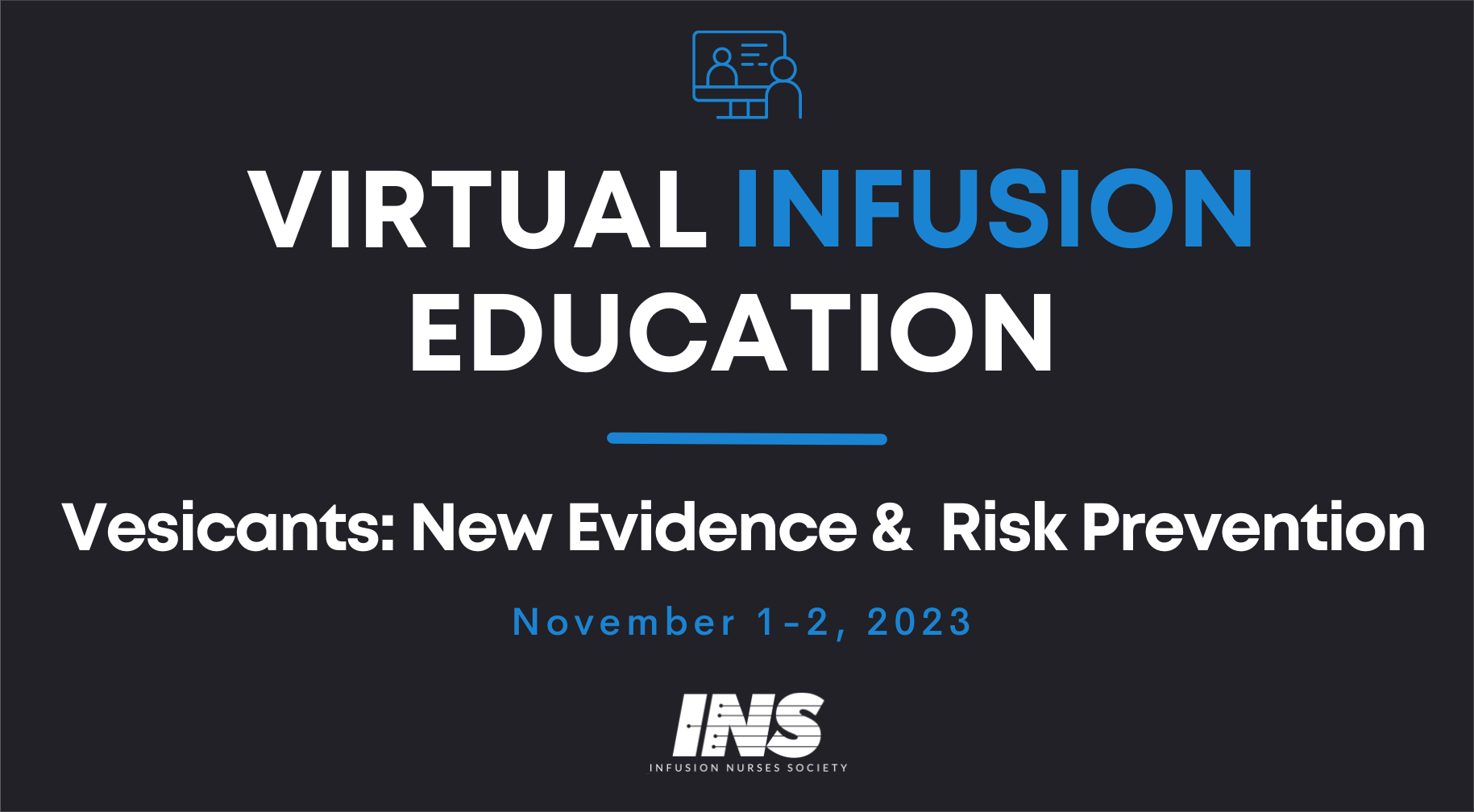
Learning Center
Agenda | November 1, 2023
1:00 pm EDT
Identifying Vesicants
Overview
Extravasation injuries are preventable when clinicians identify which medications and solutions are vesicants, understand infusion-related risks, and implement preventative interventions. In a follow-up to the 2017 Vesicant Task Force development of an evidence-based vesicant list, a new task force was formed to review and update the 2017 vesicant list, identify current issues and risks relative to vesicant administration, and revise the Extravasation Prevention Checklist. This session provides an overview of the risks of extravasation and presents the updated vesicant list.
Learning Objectives: At the conclusion of this session, learners will be able to:
1. Discuss the risks and consequences of extravasations.
2. Identify vesicant medications and solutions.
3. Differentiate between the categories of high, moderate, and cautionary vesicants.
Speaker(s)
Lisa Gorski, MS, RN, HHCNS-BC, CRNI®, FAAN,
2:15 pm EDT
VAD Planning and Site Selection to Reduce Extravasation Risk
Overview
Optimal vascular access device (VAD) planning and site selection are critical aspects of extravasation risk reduction. The push to reduce central vascular access device (CVAD) utilization rates and related serious complications has resulted in an increased use of peripheral administration of medications that have historically been reserved for CVADs. Unfortunately, this shift increases extravasation risk due to the limitations of peripheral VADs. It is critical that the clinician tailor VAD planning and site selection to the specific patient and infusate risks in a given clinical setting. This presentation will compare and contrast extravasation risks with central versus peripheral delivery, describe risk reduction strategies in peripheral VAD placement and management, and explore the risks specific to the midline peripheral catheter.
Learning Objectives: At the conclusion of this session, learners will be able to:
· Describe characteristics of peripherally compatible solutions.
· Discuss strategies to reduce extravasation risk with central versus peripheral VADs.
· Discuss extravasation risk reduction with the midline peripheral catheter.
Speaker(s)
Barb Nickel, APRN-CNS, CCRN, CRNI®,
3:30 pm EDT
Extravasation Prevention Practices
Overview
Identification and implementation of prevention practices are key to reducing the risk of extravasation and potential consequences. Prevention begins with assessment of each patient’s risk factors and the related risks associated with vascular access devices (VADs) and continues with safe administration practices. This session provides an overview of key assessments and safe vesicant administration practices.
Learning Objectives: At the conclusion of this session, learners will be able to:
1. Review known patient and vascular access device–related risk factors.
2. Describe safe vesicant administration practices.
3. Recognize early evidence of extravasation.
Speaker(s)
Ruth Van Gerpen, MS, RN, APRN-CNS, AOCNS, PGMT-BC,
Agenda | November 2, 2023
12:00 pm EDT
Malpractice and Extravasation
Overview
Extravasation may result in severe patient injuries including scarring, permanent functional impairment, lifelong or chronic pain syndromes, and even loss of limb. Extravasation injuries require treatment, hospitalizations may be prolonged, or patients may be readmitted due to the need for further interventions. Extravasations may also result in allegations of malpractice. In this session, actual malpractice cases will be described focusing on breaches in the standard of care and exploring how infusion nurses can promote best, evidence-based practice in extravasation prevention.
Learning Objectives: At the conclusion of this session, learners will be able to:
1. Define malpractice.
2. Analyze failures in care that led to extravasations and actual lawsuits.
3. Discuss the infusion nurse role in promoting best practices for extravasation prevention.
Speaker(s)
Lisa Gorski, MS, RN, HHCNS-BC, CRNI®, FAAN,
1:15 pm EDT
Extravasation: Optimizing Outcomes Through Standardized Care
Overview
Vesicant administration—and thus the risk of extravasation—occurs in most health care settings. Prevention and optimal management of extravasation injuries requires effective interprofessional collaboration and processes. This presentation will review one corporation’s journey to improve extravasation prevention, management. and outcome identification strategies through standardization of policy/procedure and vesicant list, optimizations of electronic documentation and incident reporting, and staff competency development in extravasation risk reduction and management.
Learning Objectives: At the conclusion of this session, learners will be able to:
· Identify evidence-based strategies to improve extravasation prevention and management.
· Describe benefits of interprofessional collaboration in extravasation care.
· Identify strategies to develop extravasation related competencies.
Speaker(s)
Barb Nickel, APRN-CNS, CCRN, CRNI®,
2:30 pm EDT
Q&A Panel
Overview
Q&A
Speaker(s)
Ruth Van Gerpen, MS, RN, APRN-CNS, AOCNS, PGMT-BC,
Lisa Gorski, MS, RN, HHCNS-BC, CRNI®, FAAN,
Barb Nickel, APRN-CNS, CCRN, CRNI®,
| Access Date | Quiz Result | Score | Actions |
|---|
